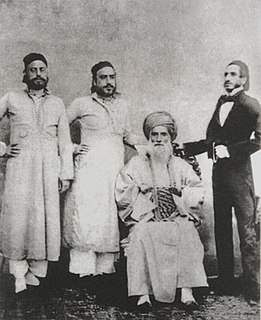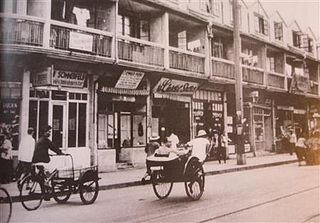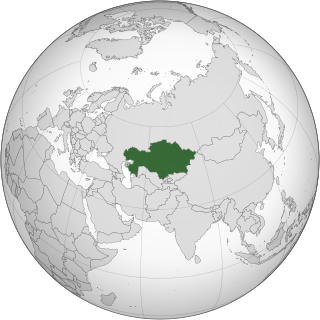Jews and Judaism in China are predominantly composed of Sephardi Jews and their descendants. Other Jewish ethnic divisions are also represented, including Ashkenazi Jews, Mizrahi Jews and a number of converts.
Shortly prior to and during World War II, and coinciding with the Second Sino-Japanese War, tens of thousands of Jewish refugees were resettled in the Japanese Empire. The onset of the European war by Nazi Germany involved the lethal mass persecutions and genocide of Jews, later known as the Holocaust, resulting in thousands of Jewish refugees fleeing east. Many ended up in Japanese-occupied China.

The former communities of Jewish migrants and their descendants from Baghdad and elsewhere in the Middle East are traditionally called Baghdadi Jews or Indo-Iraqi Jews. They settled primarily in the ports and along the trade routes around the Indian Ocean and the South China Sea.
Jews outside Europe under Axis occupation suffered greatly during the Holocaust and World War II. There was no exception to the Nazis' policy of racial discrimination and physical annihilation of the Jews. As stated by Yehuda Bauer, academic advisor at Yad Vashem, "regarding the Jews, the perpetrators were equal opportunity killers."

The Shanghai Ghetto, formally known as the Restricted Sector for Stateless Refugees, was an area of approximately one square mile in the Hongkew district of Japanese-occupied Shanghai. The area included the community around the Ohel Moshe Synagogue. Shanghai was notable for a long period as the only place in the world that unconditionally offered refuge for Jews escaping from the Nazis. After the Japanese occuped all of Shanghai in 1941, the Japanese army forced about 23,000 of the city's Jewish refugees to be restricted or relocated to the Shanghai Ghetto from 1941 to 1945 by the Proclamation Concerning Restriction of Residence and Business of Stateless Refugees. It was one of the poorest and most crowded areas of the city. Local Jewish families and American Jewish charities aided them with shelter, food, and clothing. The Japanese authorities increasingly stepped up restrictions, surrounded the ghetto with barbed wire, and the local Chinese residents, whose living conditions were often as bad, did not leave. By 21 August 1941, the Japanese government closed Shanghai to Jewish immigration.

The history of the Jews in Luxembourg dates back to the 1200s. There are roughly 1,200 Jews in Luxembourg, and Jews form one of the largest and most important religious and ethnic minority communities in Luxembourg historically.

The history of Jews in Bosnia and Herzegovina spans from the arrival of the first Bosnian Jews as a result of the Spanish Inquisition to the survival of the Bosnian Jews through the Yugoslav Wars and the Holocaust. Judaism and the Jewish community in Bosnia and Herzegovina has one of the oldest and most diverse histories in the former Yugoslav states, and is more than 500 years old, in terms of permanent settlement. Then a self-governing province of the Ottoman Empire, Bosnia was one of the few territories in Europe that welcomed Jews after their expulsion from Spain.

The history of the Jews in Kazakhstan connects back to the history of Bukharan and Juhuro Mountain Jews. Kazakh Jews have a long history. There are approximately several thousand Jews in Kazakhstan right at present.

The Mir Yeshiva, commonly known as the Mirrer Yeshiva or The Mir, was a Lithuanian yeshiva located in the town of Mir, Russian Empire. After relocating a number of times during World War II, it has evolved into three yeshivas, one in Jerusalem, with a subsidiary campus in Brachfeld, Modi'in Illit, and the other two in Brooklyn, New York: the Mir Yeshiva, and Bais Hatalmud.
Jews have been present in Hong Kong since the mid-19th century. As a major financial centre, much of Hong Kong's Jewish community is temporary in nature, largely consisting of expatriates from countries with much larger Jewish populations, such as Israel, United States, France, and other countries.
The history of the Jews in Kyrgyzstan is linked directly to the history of the Bukharian Jews of Uzbekistan. Until the 20th century, most Jews living in the Kyrgyz areas were of the Bukharian Jewish community. However, during the 20th century, large amounts of European Jews began to emigrate to Kyrgyzstan which was then part of the Soviet Union, and a small amount of them still live in the country.
The Jodenbuurt is a neighborhood of Amsterdam, Netherlands. For centuries before World War II, it was the center of the Jews of Amsterdam — hence, its name. It is best known as the birthplace of Baruch Spinoza, the home of Rembrandt, and the Jewish ghetto of Nazi occupation of the Netherlands.

The Synagogue de Nazareth is situated on the Rue Notre-Dame-de-Nazareth, in the 3rd arrondissement of Paris, and is the oldest of the 'great' synagogues of Paris. It is normally known as Synagogue Nazareth rather than Synagogue de la rue Nazareth, its official name.
The Synagogue of Neuilly-sur-Seine, located at 12 rue Ancelle, built in 1878, is the oldest synagogue in the Paris suburbs of France.

The history of the Jews in Japan is well documented in modern times, with various traditions relating to much earlier eras.

The Shanghai Jewish Refugees Museum is a museum commemorating the Jewish refugees who lived in Shanghai during World War II after fleeing Europe to escape the Holocaust. It is located at the former Ohel Moshe or Moishe Synagogue, in the Tilanqiao Historic Area of Hongkou district, Shanghai, China. The museum features documents, photographs, films, and personal items documenting the lives of some of the more than 20,000 Jewish residents of the Restricted Sector for Stateless Refugees, better known as the Shanghai Ghetto, during the Japanese occupation of Shanghai.

The Ohel Rachel Synagogue is a Sephardi synagogue in Shanghai, China. Built by Sir Jacob Elias Sassoon in memory of his wife Rachel, it was completed in 1920 and consecrated in 1921. Ohel Rachel is the largest synagogue in the Far East, and one of the only two still standing in Shanghai. Repurposed first under the Japanese occupation during World War II and again following the Communist conquest of Shanghai in 1949, the synagogue has been a protected architectural landmark of the city since 1994. It was reopened for some Jewish holidays from 1999 and briefly held more regular Shabbat services as part of the 2010 Shanghai Expo.

The Beth Aharon Synagogue was a Sephardi synagogue in Shanghai, China, built in 1927 by the prominent businessman Silas Aaron Hardoon in memory of his father Aaron. During World War II, the synagogue provided refuge for the Mirrer yeshiva of Poland, the only Eastern European yeshiva to survive the Holocaust intact. After the establishment of the People's Republic of China, it was used by the Wenhui Bao newspaper and as a factory during the Cultural Revolution. It was demolished in 1985.

The Bauska Jewish community existed in Bauska from the late 18th century until September 1941. During 19th century it was one of the main ethnic communities of the town and participated in its growth and development. Two pioneers of religious Zionism – Rabbi Mordechai Eliasberg and Rabbi Abraham Isaac Kook - lived and worked here.

Rabbi Meir Ashkenazi was a Chabad rabbi who served as chief Rabbi of Shanghai from 1926-1949.














